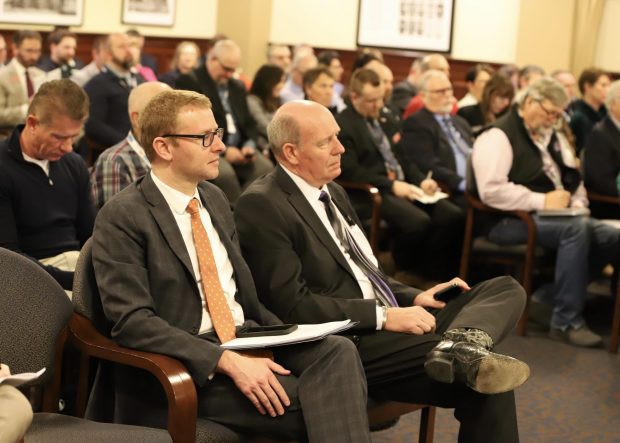The Pocatello-Chubbuck School District could get the funding it needs — or close to it — to rebuild a high school crippled by a fire last year.
A bill nearing its final hurdle in the Legislature would direct $43 million to Pocatello-Chubbuck, as part of $1 billion in state bonds dispersed to school districts. The Senate Local Government and Taxation Committee overwhelmingly voted Tuesday to send the bill to the Senate floor, recommending that it pass.
But many other districts won’t reap the same level of benefit from House Bill 521, which would divide funds through an attendance-based formula. Districts could take the funds in a lump sum or in annual installments over a decade.
The Shelley School District also needs money for a new high school, after voters last year rejected a $68 million bond measure to pay for it. Shelley’s $10 million lump sum from HB 521 wouldn’t fund construction of an elementary school, let alone a high school.
Instead of high-dollar capital projects, most districts likely will use the new funds for ongoing maintenance costs — and school leaders say they’re appreciative of that.
“I don’t think the intention is that these monies are going to be used to build a new school, because there’s just not enough money to do that,” said Shelley Superintendent Chad Williams. “But it will allow us to maintain our buildings without asking local taxpayers to pass some sort of levy or bond.”

What’s the demand for construction?
Idaho Education News analyzed data showing how much districts have requested in bonds and plant facility levies — mechanisms for funding school construction — over the last five years.
Since 2018, Idaho schools have asked for $1.6 billion in bonds and plant facility levies. Voters approved less than one third of those, leaving $1.1 billion in existing construction demand.
HB 521 more than covers that demand in terms of dollars. In addition to the $1 billion going to districts through the state bond, the bill would direct an estimated $500 million to state coffers that help districts pay down bonds and levies and save for construction costs.
Altogether, Gov. Brad Little and Republican lawmakers’ plan calls for directing $2 billion to schools, primarily for facilities. Three-quarters of it would be new spending.
“This is history in the making in the state of Idaho,” said Sen. Doug Ricks, R-Rexburg, who’s co-sponsoring the bill.
But it won’t meet the needs of every school district, particularly small, rural ones. Large, urban districts would see the biggest gains from the attendance-based formula.
To see a breakdown of district-by-district estimates, click here.
Distributions vary widely
West Ada, Idaho’s largest school district, could get $140 million, or $14 million annually. District spokeswoman Niki Scheppers in an emailed statement said HB 521 heralds “a new era of investment in educational infrastructure and resources” that “promotes fairness and equity across districts.”
Shelley, on the other hand, would have to save its $1 million annual allocation for 70 years to pay for a high school. The district likely will consider using the funds for modular classrooms and other maintenance needs, Williams said. “It’s not going to put much of a dent in the cost of building a new building.”

Even urban districts won’t have all their needs met. West Ada’s $140 million doesn’t come close to the 10-year, $500 million plant facilities levy that district voters rejected last year.
The Nampa School District, Idaho’s fifth largest, could get a $47 million lump sum from the bill. That’s a “good step in the right direction,” said Nampa Superintendent Gregg Russell, but it probably won’t cover deferred maintenance costs that are expected to exceed $100 million in the coming years.
“I’m still supportive of the bill,” Russell said. “I don’t know if it’s going to last 10 years.”
Distribution metric questioned in committee
Whether the distribution formula for HB 521 is fair, or most effective at addressing current facilities needs, has commanded much of the debate as the bill has moved through the Legislature.

Quinn Perry, deputy director for the Idaho School Boards Association, pointed to the North Gem School District, which needs a new building but would get only about $489,000 from HB 521.
“It may not even be enough to fix the boiler that they need in order to heat the school,” Perry told the Senate panel Tuesday. “Anytime you decide to send a distribution out on the amount of students attending or enrolled … the urban areas are going to win.”
Sens. Ali Rabe, D-Boise, and Treg Bernt, R-Meridian, questioned why the funds are divided based on attendance rather than condition of facilities.
Alex Adams, the governor’s budget chief, who helped craft the bill, said multiple methods were tested, but attendance has been used to distribute facility funds in the past. And it got the money to districts quickly. If the bill passes, schools could get the money next budget year, which starts July 1.
Divvying the funds based on need, on the other hand, would require a lengthy statewide buildings assessment, Adams said.

“You either have to be prepared to wait several years to get a facilities condition assessment done, or you can pick another way of distributing it,” he said. “In the out years, a more sophisticated distribution can be made, but we didn’t want perfect to be the enemy of the good.”
The Idaho Office of Performance Evaluations in a 2022 report urged policymakers to conduct a statewide school facility assessment.
Bill could affect May ballot requests
School boards across the state are anxiously watching the bill’s progress with May election deadlines approaching. Trustees are weighing whether to float bond and levy measures, which could change depending on the bill’s success.
Ballot language for the May election is due March 22.
The Kuna School Board last month voted to move forward with a $5.3 million supplemental levy measure in May. That was after considering an alternative proposal that included $2.5 million in budget cuts.
Kuna trustees said they could reduce the levy measure, depending on their HB 521 distribution. Estimates show Kuna could get a $22.4 million lump sum, or $2.2 million annually for the next 10 years.
HB 521 heads to the Senate, after the House overwhelmingly approved it.
Reporter Carly Flandro and data analyst Randy Schrader contributed to this report.
